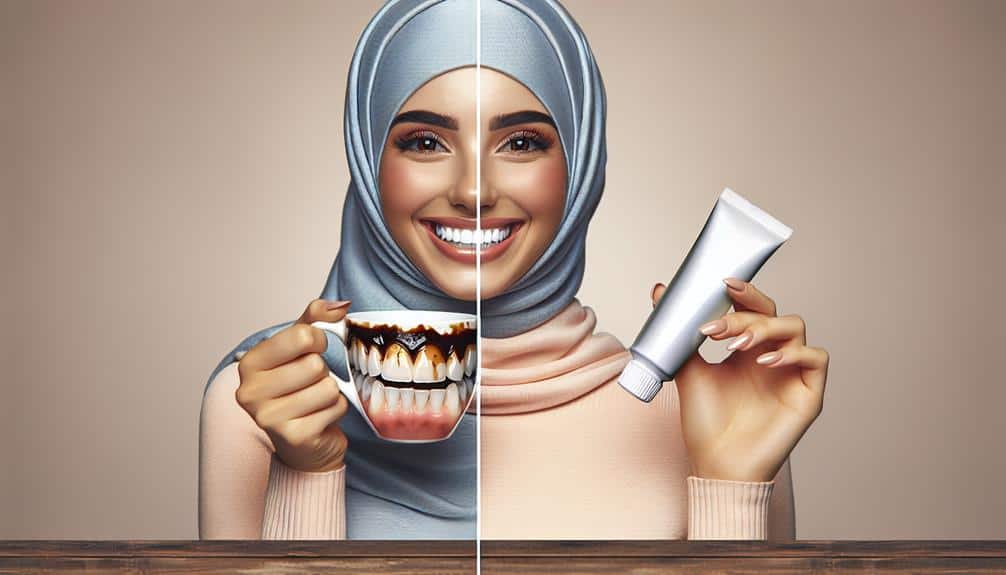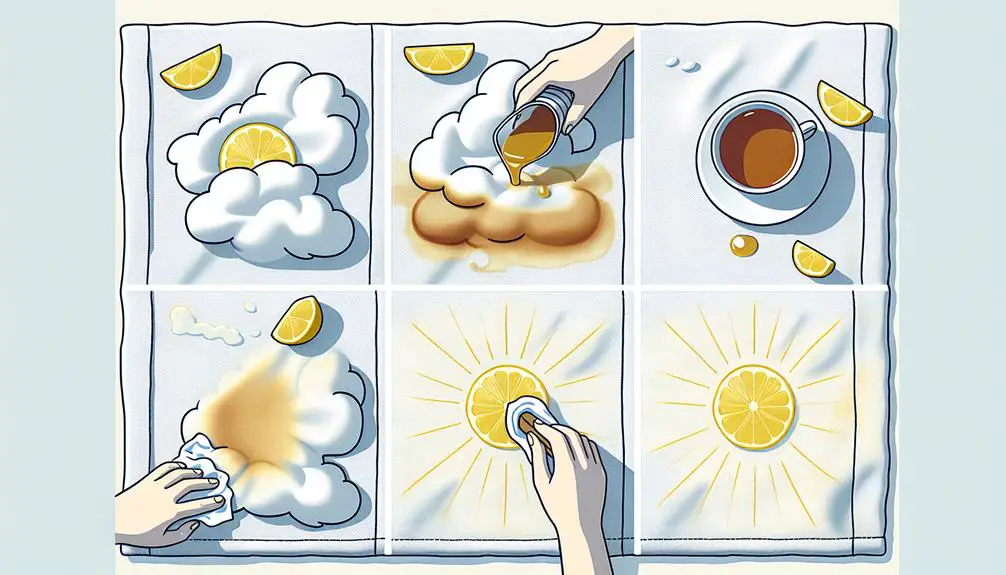To brighten your smile and remove tea stains effectively, try these methods: Brush with baking soda, rinse with hydrogen peroxide and water, and use whitening toothpaste. DIY solutions like oil pulling with coconut oil can help. Natural remedies include rubbing orange peel on teeth or using hydrogen peroxide as a mouthwash. For stubborn stains, consider professional options like laser treatments or whitening strips. To prevent future tea stains, maintain good oral hygiene, watch your diet, and care for your teeth post-whitening. Discover more ways to keep your smile bright and tea stain-free.
Key Points
- Brushing with baking soda effectively removes tea stains.
- Rinsing with hydrogen peroxide aids in stain removal.
- Using whitening toothpaste gradually reduces tea stains.
- Oil pulling with coconut oil is a traditional remedy.
- Regular dental visits and good oral hygiene are essential.
Causes of Tea Stains on Teeth
Tea stains on teeth are primarily caused by the tannins present in tea, which can easily adhere to the enamel surface. Tannins are natural compounds found in tea that make it flavorful but also have a staining effect on teeth. To prevent tea stains, maintaining good dental hygiene is essential. Brushing your teeth at least twice a day with a fluoride toothpaste and flossing daily can help remove plaque and prevent the buildup of stains. Additionally, regular visits to the dentist for important cleanings are vital in maintaining oral health and preventing tea stains from becoming stubborn.
Incorporating preventive measures like reducing the frequency of tea consumption, using a straw to drink tea, or rinsing your mouth with water after drinking tea can also help minimize the chances of developing tea stains on your teeth. By being proactive in your dental care routine and making small adjustments to limit the exposure of tannins to your teeth, you can effectively prevent and reduce tea stains for a brighter, healthier smile.
Common Tea Stain Removal Techniques
To effectively remove tea stains from your teeth, various common techniques can be employed. DIY solutions and home remedies are often used by individuals looking to brighten their smiles.
One popular method is to brush your teeth with baking soda. Its mild abrasive properties can help scrub away surface stains caused by tea.
Another effective technique is to rinse your mouth with a mixture of hydrogen peroxide and water. This solution can help lighten stains and kill bacteria in the mouth.
Additionally, using a toothpaste with whitening properties can gradually reduce tea stains over time. Some people also turn to oil pulling, a traditional method that involves swishing coconut oil around in your mouth to remove toxins and stains.
Natural Remedies for Tea Stain Removal
For effective removal of tea stains naturally, incorporating certain home remedies into your oral care routine can yield promising results. When looking to tackle tea stains at home, consider trying some DIY techniques that are gentle yet effective.
One popular home remedy is brushing your teeth with a paste made of baking soda and water. Baking soda is known for its mild abrasive properties that can help lift stains from the surface of your teeth.
Another option is to rub the inside of a fresh orange peel on your teeth before brushing. The natural acids in the orange peel can help break down stains.
Additionally, using hydrogen peroxide as a mouthwash or mixing it with baking soda to create a paste can also aid in removing tea stains. Remember to use these home remedies in moderation to avoid damaging your enamel.
Professional Whitening Options Available
Considering professional whitening options for your teeth can provide a quick and effective solution to remove stubborn tea stains and achieve a brighter smile. Two popular options for professional teeth whitening are laser treatment and whitening strips.
Laser treatment is a sophisticated method where a dental professional applies a bleaching agent to your teeth and then uses a laser to activate the whitening process. The laser helps to accelerate the bleaching effect, resulting in significant stain removal and a noticeable improvement in the whiteness of your teeth. This treatment is typically done in a dental office and can provide rapid results.
On the other hand, whitening strips are a more convenient at-home option. These strips are coated with a bleaching gel that you apply directly to your teeth. The gel works to break down and lift away the tea stains, revealing a brighter smile over time with consistent use. Whitening strips are user-friendly and can be a cost-effective solution for achieving whiter teeth.
Preventing Tea Stains After Whitening
Implementing consistent oral hygiene practices and making mindful choices in your diet can play a significant role in preventing tea stains from reappearing after whitening treatment. After undergoing professional whitening, it's essential to maintain good oral habits for post-whitening care.
Brush your teeth at least twice a day with a fluoride toothpaste to remove surface stains and prevent plaque buildup, which can attract stains. Flossing daily is equally important as it helps remove food particles that can cause discoloration between teeth. Consider using a whitening toothpaste to help maintain your bright smile.
Additionally, avoid or limit foods and beverages known to stain teeth, such as tea, coffee, red wine, and dark sodas. If you do consume these beverages, use a straw to minimize contact with your teeth. Regular dental check-ups and professional cleanings can also aid in stain prevention by removing any accumulated plaque or tartar.
Frequently Asked Questions
Can Drinking Tea Through a Straw Help Prevent Tea Stains on Teeth?
Using a straw to drink tea can reduce direct contact with teeth, potentially minimizing tea stains. It's a simple and effective preventive technique. Take advantage of this easy tip to keep your smile bright!
Will Using a Whitening Toothpaste Remove Tea Stains as Effectively as Professional Whitening Treatments?
Using a whitening toothpaste may not remove tea stains as effectively as professional treatments. DIY remedies could help, but be cautious of tooth sensitivity. Natural alternatives are gentler to avoid enamel damage. Consider professional advice.
How Often Should I Visit the Dentist for Professional Teeth Whitening Treatments?
To sustain your pearly whites, aim for dental check-ups every six months. For professional teeth whitening treatments, consult your dentist for personalized advice on frequency. Regular visits guarantee your smile stays radiant and healthy.
Are There Any Specific Foods or Drinks to Avoid After Whitening to Prevent New Tea Stains From Forming?
After whitening, avoid dark-colored foods and drinks like coffee and berries to prevent new tea stains. Opt for lighter options to maintain your bright smile. Practice good oral hygiene, and consider using a straw for beverages.
Can Tea Stains on Teeth Be a Sign of Underlying Dental Health Issues?
Tea stains on teeth can indicate underlying dental issues. Regular dental checkups are essential for prevention. Excessive tea consumption may impact oral health. Stay proactive with oral care to avoid potential problems and maintain a healthy smile.



